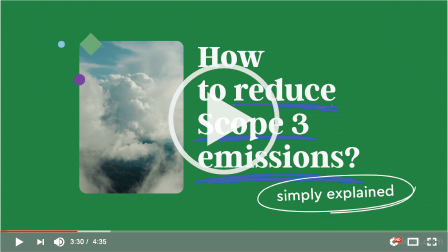Sustainability has become a pressing priority for all organizations. Recent research conducted by the financial data firm Sentineo Inc. has found “scope 3” to be mentioned at least once in 689 transcripts of quarterly earnings in 2021. That’s 15 times the amount of mentions in 2019.
While greenhouse gases like CO2 emissions have been a standard sustainability KPI for some time, scope 3 emissions are a more obscure measure that extends far beyond the company’s own emissions.
Companies can lean on procurement to bring visibility to these indirect emissions. This article covers what Scope 1, 2, and 3 emissions are, and what procurement can do about them.

What are Scope 1, 2, and 3 emissions?
The Greenhouse gas (GHG) protocol is the world’s most widely used greenhouse gas accounting standard. Since 2001, governments, NGOs, and corporations have used their principles in accounting for GHG emissions.
According to their report, Corporate Value Chain Accounting Reporting Standard, GHG emissions can be classified into 3 “scopes.”
Scope 1 emissions are those which come directly from owned and controlled company sources (like production facilities and transportation vehicles).
Scope 2 emissions are from facilities that provide energy that is bought and consumed by the company, also known as indirect emissions.
Scope 3 emissions originate outside of the company, such as from other companies in the supply chain or end-users.

Procurement's role in reducing scope 3 emissions
While scopes 1 and 2 are generally straightforward to measure and are a clearly defined requirement for GHG reporting, scope 3 emissions are more flexible in their reporting.
For instance, if you were measuring the emissions of a manufacturing plant producing cars, scope 1 would be the energy used in production and transport, scope 2 would be emissions from purchased electricity, heating or cooling, and scope 3 could be everything from supplier emissions to the emissions produced during the destruction of the car twenty years from now.
While scope 1 and scope 2 are clear-cut sources of emissions, scope 3 represents the most significant source of GHG emissions. With that being said, it is also the area where procurement has the greatest chance to influence GHG reductions and achieve business objectives.
If you want to see how your Scope 3 performance compares with peers, Sievo and Deloitte offer a free benchmark tool covering emission intensity and procurement maturity.
Procurement objectives tied to Scope 3 emissions
Here are some of the business goals the GHG protocol identifies and how they relate to procurement (see page 12 of this report).
Partnership
Procurement should be looking for more ways to collaborate with suppliers, customers, and other companies in the value chain.
This puts procurement in the best position to positively influence supplier relationships and align sustainability goals.
Increasing transparency
Expanding accountability, transparency, and management in the supply chain is par for the course in Procurement.
Spend analytics is one such way to achieve visibility and transparency on goods and services and can be led by procurement initiatives. This especially applies to identifying sources of scope 3 emissions.
Targeting category hotspots that are high-risk areas for scope 3 emissions is a procurement-led capability supported by spend data.
Supplier relationship management
Transparency into supplier performance goes hand in hand with your efforts to engage suppliers.
Through effective relationship management and open communication, procurement can incentivize suppliers to engage in sustainability goals through partnership, not just quotas.
Cost reduction and savings
Finally, reducing energy use and risks in the supply chain impacts cost management. You can avoid future costs related to energy and emissions.
Supply chain efficiency and reduction of material, resource, and energy use is a direct result of reducing scope 3 emissions. Consolidation and efficiency of supply chains is an important procurement contribution.
The time to act is now
With scope 3 emissions becoming the focus for many companies, procurement has a real chance to bring visibility and transparency to GHG emissions throughout the supply chain and beyond.
This includes tracking GHG emissions of purchased goods and services as well as working closely with suppliers in the value chain.
To learn more about Sievo can help you, watch this talk from ImpactNow, our sustainability event:
To see more talks, watch SievoFriends 2022 on demand.




